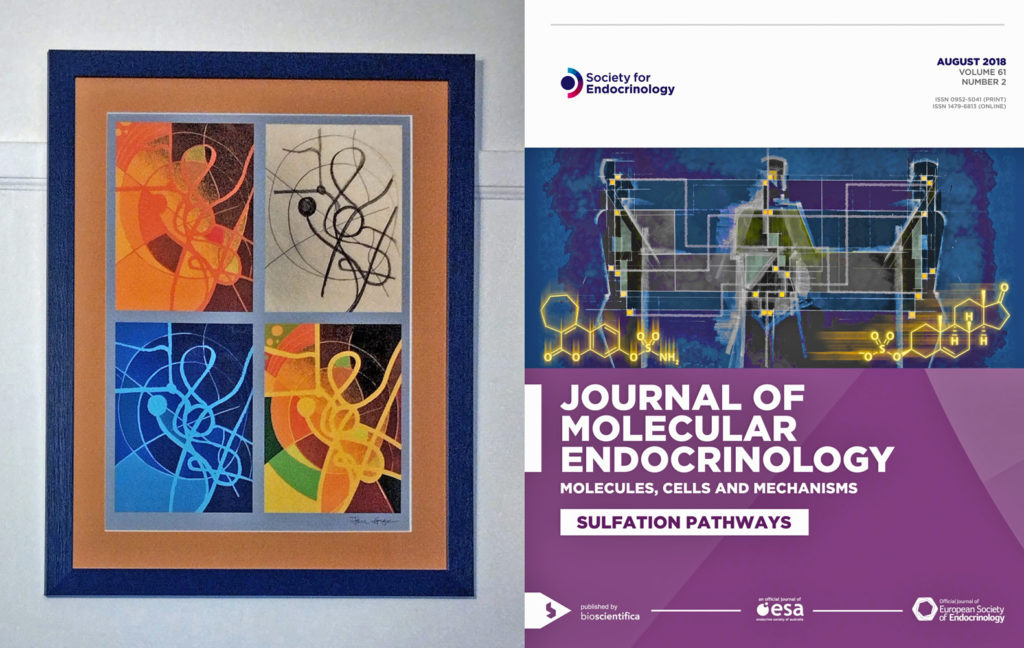Written by Jon Mueller
It has arrived. A framed print of the latest piece of art about Sulfation Pathways was delivered to my doorstep. This artwork will be the cover of a journal issue dedicated to the Sulfation Pathways research topic, realised together with the journal Frontiers in Molecular Biosciences. This work came out from a productive collaboration with Birmingham-based artist John Gage. A collaboration that has been ongoing, and John’s work has featured in previous conference posters, adverts and another front page of a Special Issue. Here, I want to reflect on my engagement with this artist.
For several years, I have been aware of John’s beautiful prints, which portray Birmingham in great detail. For a 2017 Sulfation Pathways conference in Birmingham, I contacted him to seek permission to use his depiction of Old Joe, our beloved landmark clock tower, for our conference poster – and he instantly agreed. The conference was a big success, partly due to generous support from the Society for Endocrinology. The Society also invited us to have a Special Issue in their Journal of Molecular Endocrinology. For such a dedicated volume, they asked me for suggestions for cover art and immediately I thought of John Gage again.
John and I met at the Barber Institute of Fine Arts. I explained to him that sulfation pathways are a dedicated form of biochemical transformation, where the inert “lazy” sulfate ion is activated and then transferred to a large variety of acceptor molecules; the process becomes reversible through selectively cleaving off the sulfate. I showed several illustrations of our research to the artist, we talked about art, and together we explored the superb Barber exhibition. What followed was extraordinary. John fed back to me what patterns, themes and structures he could see in our work. He then came up with beautiful artwork showing an androgynous figure from three perspectives, featuring all the glands that we are interested in massively in our institute. I added some chemical structures in motion blur. The journal editors said that this certainly isn’t something they usually publish; so this sci-art engagement helped our Special Issue to stand out. John and I later talked about our collaboration at a University-wide Worlds-Collide event, where the interaction of scientists and artists was actively fostered.
I’m very grateful that John Gage immediately agreed to collaborate again for the current Research Topic. This time I started by confessing my fascination with Birmingham’s spaghetti junction J6 of the M6. John, in return, drew inspiration from the mystic ornamental knots which feature in the Book of Kells. In the course of our discussions around science and topography on various scales, we noted the fractal similarity of the biochemical microscopic realm and the macroscopic world around us. Working on metabolic pathways such as Sulfation Pathways, one might not normally realise that others might visually perceive all those bundles of arrows, forming metabolic roundabouts, biochemical loops and regulatory cascades in completely different ways. John came up with a piece of art using a combination of hand drawing, painting, and digital media. He indulged in various layers of circle and loop structures, using a warm pallet that contains several tones of sulfuric yellows. John also drew inspiration from the intensely colourful Orphist artworks by Sonia and Robert Delaunay. I do look forward to the next sci-art project.

Figure legend: Left, cover art for the upcoming Special Issue with Frontiers in Molecular Biosciences that Jon Mueller edits currently. Right, front page of the August 2018 issue of the Journal of Molecular Biosciences.
